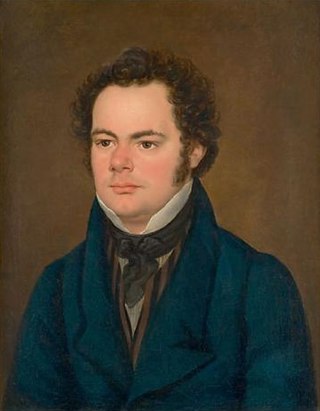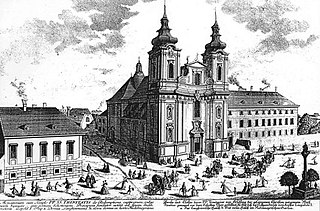
The Stabat Mater is a 13th-century Christian hymn to Mary that portrays her suffering as Jesus Christ's mother during his crucifixion. Its author may be either the Franciscan friar Jacopone da Todi or Pope Innocent III. The title comes from its first line, "Stabat Mater dolorosa", which means "the sorrowful mother was standing".
Christus am Ölberge, Op. 85, is an oratorio by Ludwig van Beethoven portraying the emotional turmoil of Jesus in the garden of Gethsemane prior to his crucifixion. It was begun in the fall of 1802, soon after his completion of the Heiligenstadt Testament, as indicated by evidence in the Wielhorsky sketchbook. The libretto in German is by the poet Franz Xaver Huber, editor of the Wiener Zeitung, with whom Beethoven worked closely. It was written in a very short period; in a letter to Breitkopf & Härtel written shortly after the oratorio's completion, Beethoven spoke of having written it in "a few weeks", although he later claimed that the piece required no more than 14 days to complete. It was first performed on April 5, 1803 at the Theater an der Wien in Vienna; in 1811, it was revised by Beethoven for publication by Breitkopf & Härtel. The 10 years that passed between the composition of the work and its publication resulted in its being assigned a relatively high opus number. The piece premiered in the United States in 1809; it was Beethoven's first success in the United States.

Mass No. 2 in G major, D 167, by Franz Schubert was composed in less than a week in early March 1815 and remains the best known of his three short settings, or missae breves, dating between his more elaborate No. 1 and No. 5. Apart from some passages for soprano, its solistic interventions are modest; Schubert, characteristically, inclines toward a devotional mood. The First Mass had been successfully performed in the composer's parish the year before.

Gioachino Rossini's Petite messe solennelle was written in 1863, possibly at the request of Count Alexis Pillet-Will for his wife Louise to whom it is dedicated. The composer, who had retired from composing operas more than 30 years before, described it as "the last of my péchés de vieillesse".
Stabat Mater, FP 148, is a musical setting of the Stabat Mater sequence composed by Francis Poulenc in 1950.
Antonín Dvořák's Requiem in B♭ minor, Op. 89, B. 165, is a funeral Mass scored for soloists, choir and orchestra. It was composed in 1890 and performed for the first time on 9 October 1891, in Birmingham, England, with the composer conducting.
Joseph Haydn's Stabat Mater Hob. XXa:1 was written in 1767, for soprano, alto, tenor and bass soloists, mixed choir, 2 oboes both doubling English horn in the sections in E-flat major, strings and organ continuo. The first performance is believed to have taken place March 25, 1768 in Vienna with soloists Anna Maria Scheffstoss and Carl Friberth, with Haydn conducting from the harpsichord. Conductor Jonathan Green suggests adding a bassoon to double the bass line and perhaps just one player to each string part.

Michael Haydn wrote the Missa pro defuncto Archiepiscopo Sigismondo, or more generally Missa pro Defunctis, Klafsky I:8, MH 155, following the death of the Count Archbishop Sigismund von Schrattenbach in Salzburg in December 1771. Haydn completed the Requiem before the year was over, signing it "S[oli] D[eo] H[onor] et G[loria.] Salisburgi 31 Dicembre 1771." At the beginning of that year, his daughter Aloisia Josefa died. Historians believe "his own personal bereavement" motivated the composition. Contemporary materials which have survived to the present day include the autograph score found in Berlin, a set of copied parts with many corrections in Haydn's hand in Salzburg and another set at the Esterházy castle in Eisenstadt, and a score prepared by the Salzburg copyist Nikolaus Lang found in Munich.

The St. Francis Mass is the shorter name for the Missa sub titulo Sancti Francisci Seraphici composed by Michael Haydn. He completed it on 16 August 1803, apparently at the request of Empress Maria Theresa for a name day celebration.
The Stabat Mater is a musical setting of the Stabat Mater sequence, composed by Luigi Boccherini in 1781 (G.532a) and revised in 1800.

Stabat Mater (P.77) is a musical setting of the Stabat Mater sequence, composed by Giovanni Battista Pergolesi in 1736. Composed in the final weeks of Pergolesi's life, it is scored for soprano and alto soloists, violin I and II, viola and basso continuo.

Stabat Mater in G minor, D 175, is a musical setting of the Latin Stabat Mater sequence, composed by Franz Schubert in April 1815. It is scored for SATB choir, 2 oboes, 2 clarinets, 2 bassoons, 3 trombones, violin I and II, viola, and basso continuo.

Mass No. 1 in F major, D 105, is a mass composed by Franz Schubert in 1814. It is scored for two soprano soloists, two tenor soloists, alto and bass soloists, SATB choir, oboe, clarinet, bassoon, 2 horns, violin I and II, viola, and basso continuo. It was the first of Schubert's masses to be performed, and is of the missa solemnis type.

Mass No. 4 in C major, D 452, is a mass composed by Franz Schubert in 1816. It was originally scored for soprano, alto, tenor and bass soloists, SATB choir, violin I and II, and basso continuo. It is classified as a missa solemnis.

Mass No. 5 in A-flat major, D 678, is a mass composed by Franz Schubert, completed in 1822. There is no record of a performance during Schubert's lifetime. It is scored for soprano, alto, tenor and bass soloists, SATB choir with divisi, violin I and II, viola, flute, 2 oboes, 2 clarinets, 2 bassoons, 2 horns, 2 trumpets, 3 trombones colla parte, timpani and basso continuo. It is classified as a missa solemnis.

Mass No. 6 in E-flat major, D 950, is a mass composed by Franz Schubert, a few months before his death. It is scored for two tenor soloists, soprano, alto and bass soloists, SATB choir with divisi, 2 oboes, 2 clarinets, 2 bassoons, 2 horns, 2 trumpets, 3 trombones, timpani, violin I and II, viola, cello, and double bass. It was Schubert's final setting of the order of Mass, and is classified as a missa solemnis.
Sonatas, duos and fantasies by Franz Schubert include all works for solo piano by Franz Schubert, except separate dances. They also include a number of works for two players: piano four hands, or piano and a string instrument.

Antonio Vivaldi composed three settings of the Dixit Dominus, the Latin version of Psalm 110. They include a setting in ten movements for five soloists, double choir and orchestra, RV 594, another setting in eleven movements for five voices, five-part choir and orchestra, RV 595, and a recently discovered setting in eleven movements for five soloists, choir and orchestra, RV 807, which had been attributed to Baldassare Galuppi. It is said to be one of his "most significant sacred works."









